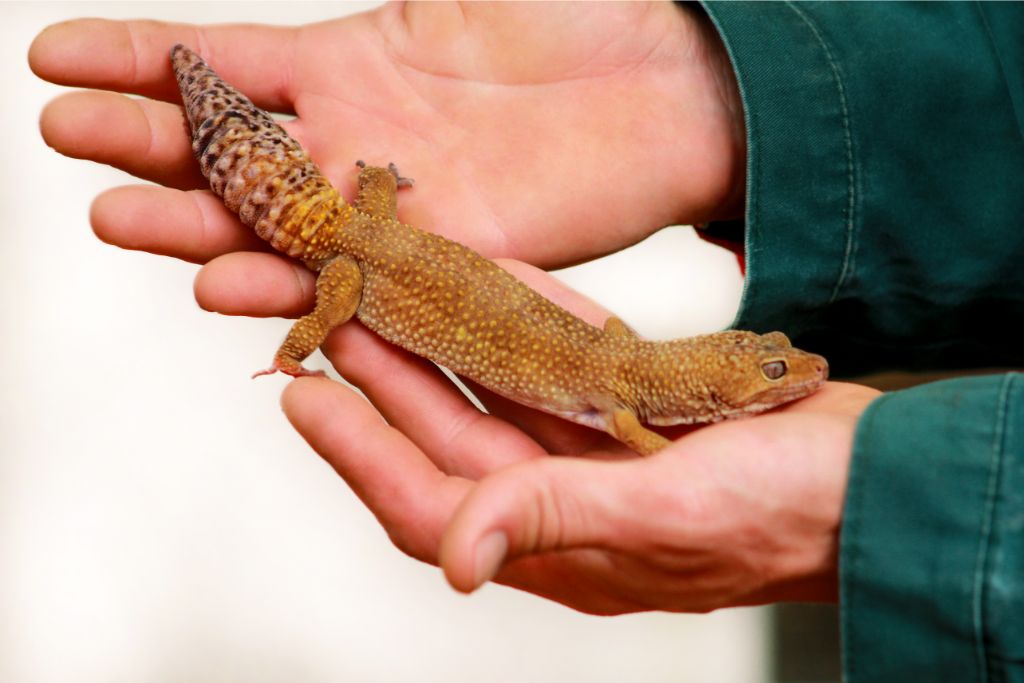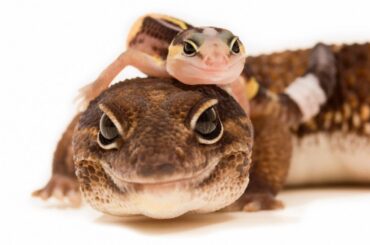Are you curious about the enchanting world of leopard geckos? Do you wonder how to connect with these captivating creatures more deeply? If you’ve ever pondered these questions, you’re in for a treat!
You might be wondering why you should go through the process of taming a leopard gecko in the first place. Think of it as building a friendship with a tiny dinosaur. Establishing trust and security with your gecko will make their life easier and is fun for you.
Leopard geckos have become immensely popular as pets for several reasons. Their adorable appearance, with those striking spots and big, expressive eyes, can melt anyone’s heart. These geckos have a reputation for being one of the most docile and friendly reptiles you can have as a pet.
The Process of Taming Leopard Geckos
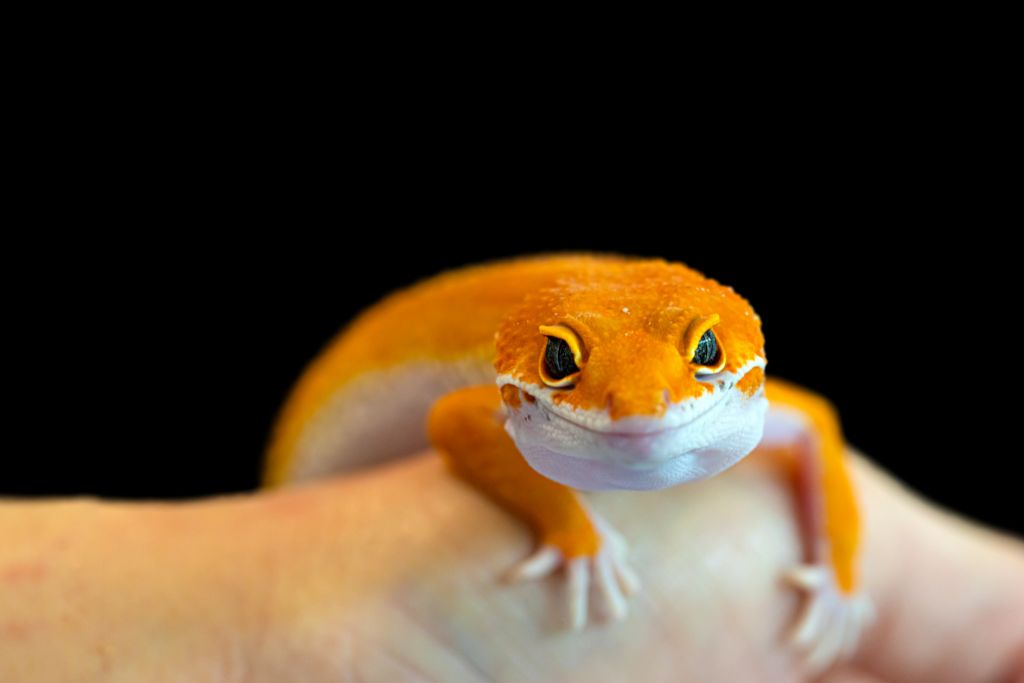
You must trust and bond with a leopard gecko to tame it, and that requires time and patience. Here are the stages to a happy, friendly leopard gecko:
Creating a Suitable Habitat
Leopard geckos need a cozy habitat like you do. Start here to learn how to give your leopard gecko the best home!
- Warm and Cozy Hideout: Leopard geckos love warmth, so ensure a cozy hideout in their habitat. This hideout should be snug and just the right size for your gecko to curl up in. It will give them protection and a refuge to escape the world.
- Proper Temperature: Cold-blooded leopard geckos depend on external influences to control their body temperature. Keep one side of the enclosure warm (89℉) and the other chilly (75-80℉) with an under-tank heater or heat lamp. This temperature gradient allows them to choose their preferred warmth level.
- Good Lighting: While leopard geckos don’t need bright, blinding lights like we do, they benefit from a day-night cycle. Use a low-wattage bulb or a reptile-specific light that mimics natural sunlight for 10 to 12 hours a day. This helps maintain their biological rhythms and keeps them active and healthy.
- Safe Substrate: The substrate is what covers the bottom of the enclosure. Avoid using substrates like sand, which can be harmful if ingested. Opt for safer options like paper towels, reptile carpets, or non-adhesive shelf liners. These are easier to clean and won’t pose a risk to your gecko’s health.
- Adequate Space: Leopard geckos may be small, but they still need enough space to move around comfortably. A 20-gallon tank is ideal for one leopard gecko, but if you have several, increase the capacity.
- Food and Water Dishes: Use shallow dishes for food and water to make it easy for your gecko to access their essentials. Be sure to keep these dishes clean and provide fresh water daily.
Building Trust and Familiarity
Allowing your new gecko to adjust to its new home is crucial. Like people who feel nervous in new places, geckos require time to acclimate.
Geckos are habitual and thrive in secure habitats. Allowing your gecko to adjust to its new home gradually reduces stress and anxiety. This adjustment period allows them to explore, learn, and build trust in their new environment.
Be patient and let your gecko take its time to settle in. In the long run, it will make for a happier and healthier gecko-human relationship.
Gradual Interaction
Like the leopard gecko, each animal has its unique way of interacting with the world around it. Explore how we may bond with these amazing creatures by studying their actions and needs.
1. Begin with a Gentle Approach
When taming your leopard gecko, the journey starts with a gentle approach. Start by sitting near their enclosure quietly. This allows them to get used to your presence without feeling threatened.
2. Slow and Calm Movements
As you reach out, remember that slow and calm movements are key to success. Swift or jerky motions can make your gecko nervous. Gradually, your gecko will become accustomed to your hand being around without feeling alarmed.
3. Give Them Space
Just like us, leopard geckos appreciate personal space. Don’t rush the process. Allow your gecko to investigate your hand at their own pace. Some may take longer to warm up to you, and
that’s perfectly okay.
4. Respect Their Signals
Leopard geckos may communicate their comfort level through body language. If they seem tense, it’s best to retract your hand and give them some more time. If they appear relaxed, you can continue the interaction, always being gentle and patient.
Hand-Feeding and Positive Associations
Check out hand-feeding’s unique benefits and how it can help you bond with your leopard gecko.
- Reducing Fear and Stress: The world can be a big, scary place for leopard geckos. Hand-feeding can help reduce their fear and stress. By offering food from your hand, you show them that you’re a friendly provider, not a threat.
- Learning Their Preferences: Leopard geckos have unique taste preferences. Hand-feeding lets you learn what insects or worms they enjoy the most. This knowledge helps you provide the best diet for your pet.
- Observing Their Health: Regular hand-feeding lets you observe your leopard gecko closely. You can watch their diet for health issues, including hunger or behavior changes.
- Creating Positive Memories: Like humans, leopard geckos can remember positive experiences. When you hand-feed, you’re creating lasting memories of enjoyable moments. These memories can reinforce the bond between you and your gecko.
Gauging Comfort Levels
Understanding your gecko’s comfort level is essential for its safety and happiness in its habitat. The best method to achieve this is to watch its body language. Geckos, like people, use body cues to communicate their feelings.
When your gecko’s tail is straight and held up, it indicates confidence and comfort. If you notice its curled or bent tail, it might feel stressed or threatened. Another essential sign to watch for is its eyes. A gecko with relaxed, half-closed eyes usually feels at ease, while wide-open eyes can signify fear or discomfort.
Pay attention to its body posture. A gecko flattened against a surface may be concealing or sheltered, while one exploring its enclosure may be curious and joyful. By watching these subtle body language signs, you may make your gecko feel at home in a happier, healthier environment.
Ways to Reduce Stress During Interactions
To reduce stress during interactions with your leopard gecko, use these gentle techniques:
- Proper Temperature: Maintain the right temperature in the tank. Geckos like it warm, so a heat lamp or mat can help.
- Clean Tank: Keep the enclosure clean to prevent any infections or discomfort.
- Slow Movements: Approach your gecko slowly and avoid sudden gestures to prevent startling it.
- Use Clean Hands: Wash your hands before handling to avoid transferring harmful substances.
- Support the Body: Always support your gecko’s body to make it feel safe.
Proper Handling Techniques
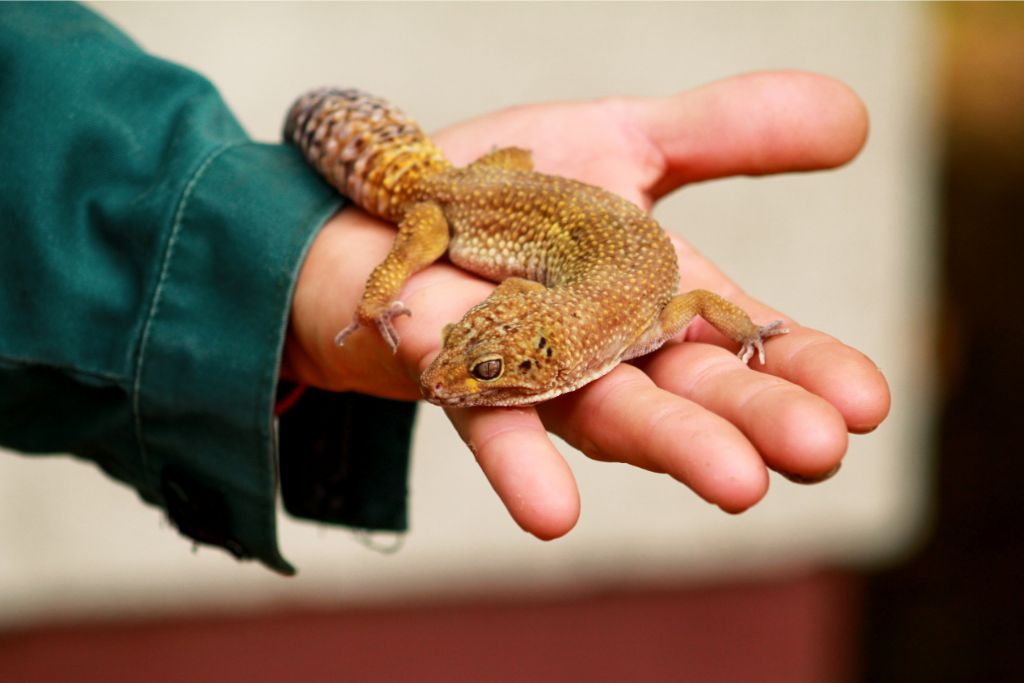
When handling your leopard gecko, it’s essential to do it right to keep your scaly friend safe and happy. Imagine picking up your gecko as if gently holding a delicate treasure. Start by using both hands to scoop them up from underneath. Place one hand beneath their belly and the other supporting their hind legs.
For a secure grip, ensure your fingers are gently curled around their body, like a soft cradle. This way, your gecko won’t feel squished or scared. Keep your movements slow and steady so your gecko doesn’t get startled. By holding your gecko this way, you’re making sure they feel safe and supported.
Regular Handling Routine
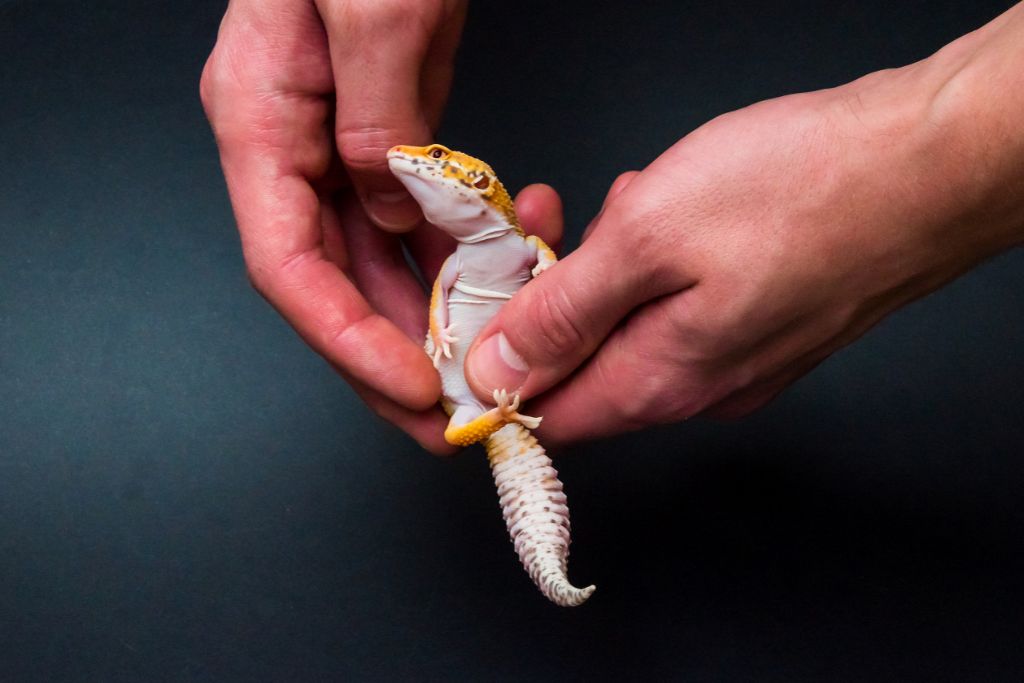
One of the keys to building a solid and lasting bond with your furry friend is through regular handling sessions. Your pet benefits from these sessions just like we do from spending time with friends and family to preserve ties. It makes them familiar with your touch, scent, and voice.
First, start with short and gentle interactions. For example, spend just a few minutes petting them and talking softly. Extend the session by a minute or two as days go by. The goal is to make your pet comfortable and confident with your touch. These encounters will become more calm and trusting with time, developing your special bond.
Troubleshooting Challenges
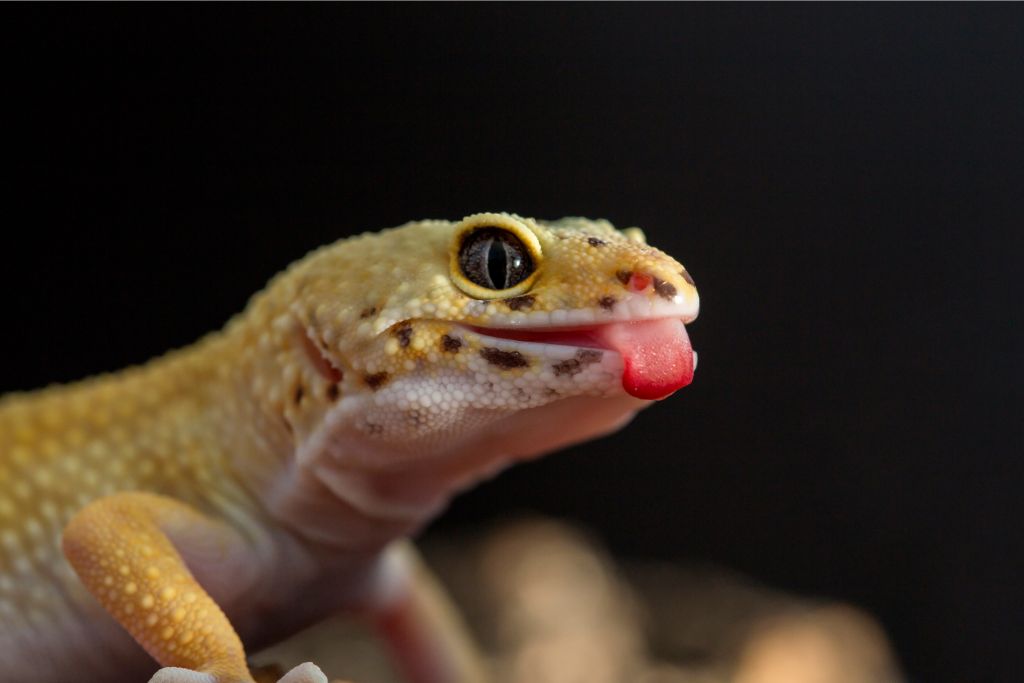
Raising a pet can be fun but comes with its fair share of challenges. Your furry friend might start biting, dropping its tail, or even refuse to eat, leaving you scratching your head. Here are some tips to help you through these hiccups:
- Biting: If your pet is nibbling on everything in sight, it could be teething or playful behavior. To tackle this, make sure they have plenty of chew toys to sink their teeth into. Redirect their attention when they bite something they shouldn’t by offering a toy and praising them when they choose it.
- Tail Dropping: If your pet drops its tail, it might be scared or stressed. Create a cozy environment with their favorite toys and a comfy bed. Spend quality time with them to build trust and make them feel secure.
- Refusal to Eat: Pets, like us, can have picky eating habits. If they turn their nose up at food, change their diet gradually. Introduce new flavors slowly and make sure their food is fresh and appealing. If the problem persists, consult your vet, but with patience and testing, you’ll find the proper meal they’ll love.
Conclusion
Patience, consistency, and respect for your gecko’s comfort are the keys to a successful taming journey. These qualities are like the magical ingredients that will help you build a strong bond with your scaly friend. It’s not about rushing things or expecting instant results but taking it one step at a time.
Don’t be discouraged if your gecko doesn’t warm up to you immediately. Keep offering them tasty treats, talking softly, and handling them gently. With time and effort, you’ll find yourself with a gecko pal who’s just as excited to see you as you are to see them.
FAQs
How to Tame an Aggressive Leopard Gecko?
Taming an aggressive leopard gecko requires a patient and gradual approach. Start by giving the gecko time to acclimate to its environment. Then begin handling it gently and with slow movements to avoid startling it. Hand-feeding can help build trust, using tongs to prevent accidental bites.
How Long Does It Take to Tame a Leopard Gecko?
Leopard geckos have different personalities and adjust at different speeds, so taming might take weeks or months. Taming the gecko requires patience and a stress-free experience for both of you.

